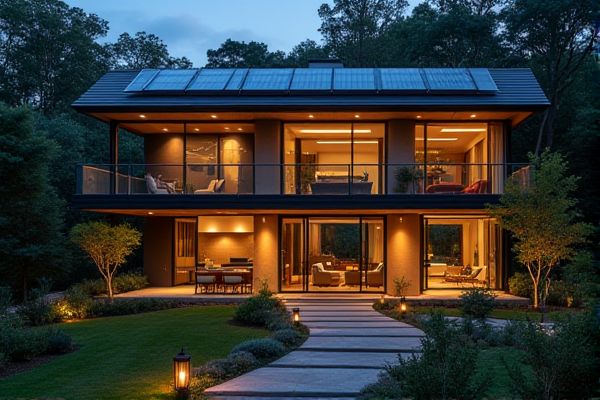
Solar lighting offers energy-efficient, eco-friendly illumination with easy installation and low maintenance by harnessing sunlight, while wired lighting provides consistent, high-powered light with greater control and reliability but requires complex setup and ongoing energy costs. Discover the key factors to consider when choosing between these lighting options for your space by reading the full article.
Table of Comparison
| Feature | Solar Lighting | Wired Lighting |
|---|---|---|
| Power Source | Solar energy via photovoltaic panels | Electric grid connection |
| Installation | Easy, no wiring needed | Complex, requires electrical wiring |
| Cost | Higher initial cost, low operating cost | Lower initial cost, higher energy bills |
| Energy Efficiency | High, uses renewable energy | Depends on grid power source |
| Maintenance | Low, mainly panel cleaning and battery replacement | Moderate, bulb and wiring maintenance |
| Environmental Impact | Eco-friendly, zero emissions | Potentially higher emissions, based on power source |
| Reliability | Dependent on sunlight availability | Consistent, powered by grid |
| Mobility | Portable and flexible | Fixed installation |
| Best Use Cases | Remote areas, outdoor lighting, energy-saving projects | Indoor lighting, locations with stable grid access |
Introduction to Solar Lighting vs Wired Lighting
Solar lighting harnesses energy from the sun through photovoltaic panels, offering an eco-friendly and cost-effective solution with minimal installation requirements. Wired lighting relies on electricity supplied through cables, providing consistent illumination but often involving higher installation costs and limited placement flexibility. Your choice depends on factors like energy consumption, installation complexity, and environmental impact.
Energy Source and Sustainability
Solar lighting harnesses renewable energy from the sun, significantly reducing greenhouse gas emissions and reliance on fossil fuels compared to wired lighting, which typically depends on electricity generated from non-renewable sources. Your choice of solar lighting enhances sustainability by utilizing clean, abundant solar power, decreasing environmental impact and operational costs over time. Wired lighting, while consistent in performance, often involves higher energy consumption and carbon footprint, making solar lighting a more eco-friendly and energy-efficient solution.
Installation Process and Costs
Solar lighting involves a straightforward, cable-free installation process that typically requires minimal labor and no trenching, significantly reducing upfront costs compared to wired lighting systems. Wired lighting demands professional installation with complex electrical wiring, trenching, and potential permits, resulting in higher labor and material expenses. Choosing solar lighting can streamline your setup while lowering installation costs, especially in areas without existing electrical infrastructure.
Maintenance Requirements
Solar lighting requires minimal maintenance, primarily involving occasional cleaning of solar panels and battery checks, which reduces long-term upkeep costs compared to wired lighting. Wired lighting systems often demand regular inspections for electrical faults, wiring damage, and component replacements, increasing maintenance complexity and expenses. The autonomous operation of solar lights eliminates the risk of power outages caused by wiring issues, contributing to lower maintenance needs overall.
Performance and Reliability
Solar lighting offers high reliability in areas with abundant sunlight, utilizing photovoltaic panels to convert solar energy into electricity, ensuring continuous operation during daylight and energy storage for nighttime use. Wired lighting systems provide consistent performance regardless of weather conditions by drawing power directly from the electrical grid, guaranteeing uninterrupted illumination. Performance depends on factors like solar panel efficiency, battery capacity, and grid stability, with wired lighting excelling in reliability but solar lighting gaining advantages in energy independence and lower operational costs.
Aesthetic and Design Flexibility
Solar lighting offers unparalleled design flexibility by eliminating the need for wiring, allowing you to place fixtures in virtually any location without restrictions. Its sleek, wireless appearance enhances aesthetic appeal, blending seamlessly with various architectural styles and outdoor landscapes. Wired lighting, while often providing more consistent power, limits installation options and can involve visible cables that detract from a clean, modern look.
Environmental Impact
Solar lighting significantly reduces carbon emissions by harnessing renewable energy from the sun, eliminating the need for electricity generated from fossil fuels. Wired lighting relies on grid electricity, which often comes from non-renewable sources, contributing to greenhouse gas emissions and environmental pollution. The production and disposal of wiring and associated infrastructure further increase the environmental footprint compared to the cleaner lifecycle of solar lighting systems.
Long-Term Cost Savings
Solar lighting offers significant long-term cost savings by eliminating electricity bills and reducing maintenance expenses compared to wired lighting systems. Wired lighting requires ongoing energy consumption and higher installation costs due to complex electrical work, making it less economical over time. By choosing solar lighting, you invest in a sustainable solution that minimizes operational costs while maximizing energy efficiency.
Ideal Applications and Use Cases
Solar lighting excels in remote or off-grid locations where wiring is impractical, making it ideal for garden paths, parking lots, and outdoor security. Wired lighting suits consistent power needs in indoor settings, commercial spaces, or areas requiring high illumination levels like warehouses and offices. Your choice depends on access to electricity, installation cost, and maintenance preferences for effective lighting solutions.
Choosing the Best Lighting Solution
Solar lighting offers energy-efficient, cost-effective illumination with minimal installation, ideal for outdoor spaces where wiring is impractical or expensive. Wired lighting provides consistent power and higher brightness levels, suitable for indoor use or areas requiring stable, long-term lighting. Evaluating location, budget, and maintenance needs is crucial when choosing between solar and wired lighting solutions.
 homyna.com
homyna.com